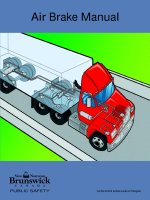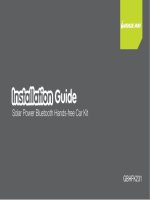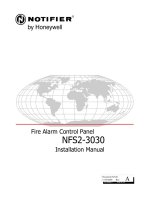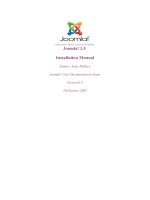KAC conversion kit installation manual
Bạn đang xem bản rút gọn của tài liệu. Xem và tải ngay bản đầy đủ của tài liệu tại đây (8.03 MB, 32 trang )
-Vehicle InformationManufacturer : TOYOTA(Japan)
Car Model : COSTER (MINI BUS)
Passenger : 25 people
Similar Model : Hyundai Chorus,
Hyundai County, Kia Combi
-Engine InformationEngine type
14B(with out TURBO)
Displacement
3,660 cc
Cylinder bore
102.0 mm
Piston stroke
112.0 mm
Compression ratio
18:01
Cylinder block alloy
cast-iron
Cylinder head alloy
cast-iron
Cylinder liner
dry liner
Valvetrain
OHV
HP
98 at 3,400RPM
Torque
24kg f-m at 1,800RPM
Injection type
direct injection
Fuel type
diesel
-Electrical Field Information-
Generator
24v / 30A (assumption)
Battery Capacity 65AH(2EA) CCA700A(assumption)
1. This Install Manual is contributed to workers in order for them to
understand rules and directions of converting diesel engine into
CNG(Compressed Natural Gas) engine.
2. Matters that require attention
1) Workers ought to protect their own health during installation job.
Be careful of safety accidents all the time.
2) Vehicles are very sensitive to heat, vibration, moisture, and etc.
more than general machines.
3) This install manual recommends optimal installation, based on our
know-how for conversion into CNG engine. If installation job is
followed by our recommendation, durability of engine and other parts
can be extended. However, installation job can be influenced by
worker’s idea in accordance with environment or condition of work.
However, workers have to consider content 2. 2) all the time.
Engine Checking
1. Idling state of the Engine (Cylinder dissonance)
2. Check all of the liquid condition flowing into the engine(rust, engine oil level) and check leak
- If you need, cleanse or exchange it
3. Visually inspect the exhausted gas if it emit different kind of gas, and expect the inside condition
of the engine.
4. Check starting device
5. Check HVAC system
Problem of engine
4th piston and piston ring
got damaged
4th cylinder liner got
damaged
Determine to replace them
Over sized 14B 0.50mm piston
1. Remove carbon from the piston
2. Make the piston keep horizontal
3. Measure water volume by using a shot or electronic scale as like
the picture.
4. In the case of using an electronic scale, convert 1g into 1cc of
water.
5. The level of water should be the same as the level of the piston
surface.
▣ Install Manual – Compression Ratio of Cylinder(1)
Calculate Cylinder Voulme
VCyl
D
π 2
D H
4
If D 12 Cm H 14.5 Cm ,
π 2
12 14.5 Cm 3
4
1639.911 (cc)
VCyl
H
1640 (cc)
If Piston Water M easure Volume
is 80 cc ,
Total Cylinder Volume
1640 80
1720 cc
BDC
Piston
Water
Measure
Volume
TI-4 2/6
▣ Install Manual – Compression Ratio of Cylinder(1)
Calculate Combustion Room Volume
Head
If Compression Ratio is 16.2 : 1,
16.2 : 1 1720 : Vcombustion
1720
Vcombustion
16.2
106.17
TDC
Cylinder
Piston
106 cc
Cobustion Room Volume
except Piston Water Measure Volume
Vresidual 106 80
26 cc
TI-4 3/6
Piston
Water
measure
Volume
▣ Install Manual – Compression Ratio of Cylinder(1)
Calculate Combustion Room Volume
Head
If Compression Ratio is 16.2 : 1,
16.2 : 1 1720 : Vcombustion
1720
Vcombustion
16.2
106.17
TDC
Cylinder
Piston
106 cc
Cobustion Room Volume
except Piston Water Measure Volume
Vresidual 106 80
26 cc
TI-4 3/6
Piston
Water
measure
Volume
▣ Install Manual – Compression Ratio of Cylinder(1)
Calculate Processing Diameter using Piston Precessing Volume
If the depth of Piston Water Measure Volume is h 2 Cm,
d 2 2 138 cc
4
d 9.375 Cm
d
h
Attention : While processing piston, keep the depth of piston water measure volume.
If the depth of it is adjusted, oil line gets damaged.
TI-4 5/6
Draw up and work on machining the piston based on the calculation you’ve done
1. Make the all edges be round (work for preventing hot spot)
2. Make the water chamber be finished with soft sand paper
3. Put some oil for preventing high temperature while machining
1.8mm
69.97cc
R2
14B Diesel piston
14B CNG piston
101.44mm
6.88mm
R8
Piston placement Piston machining Photo of
finished piston
Check the water volume of completed piston and
remedy it delicately
Apply head inspection plug
1. Replace or reuse it after checking damage or deformation of the surface of head and the condition of valve and valve
seal.
2. Determine applied spark plug after checking diameter of diesel injection nozzle and the distance of valves.
Tips for determination: machined plug tap should not be exceeded the range of the valve seat, and 14mm is
recommended. –See the pictures-
Expand the bore for inserting the I/G cable
Check the size of machined M14-1.25P The
surface of finished cylinder head
1. While assembling spark plug, adjust the
level of screw thread by using plug washer in
order not to be exposed to combustion.
Remove placed fuel pump and front case Work on machining shaft taper based on fuel pump
shaft (refer the sample) work on machining the front case in order to equip 6204ZZ(2EA) bearing
Retainer standard (25-50-12) work on machining the tap so that the shaft and the wheel
sprocket could be fixed (M8-1.25P) Check the condition of the taper which is assembled with
genuine gear Invent or purchase special tool in order to assemble the nuts inside of the
genuine gear. (nut size 17mm-diameter of the tool 22mm)
Assemble the machined wheel sprocket shaft and the bearing
Affix CPS sensor carefully and array it with the forth point of the
engine TDC direction of rotation the method of arraying the
timing gear is followed TOYOTA method as usual except for the
wheel sprocket gear.
Disassemble the equipped T/B and air heater
Produce a T/B flange by referring the picture on the left side
and the sample
Design the bore of T/B flange should be bigger or the same as
the bore of T/B
Place T/B flange by applying silicon outside of it
Assemble the T/B
As like the picture above, assemble 3way valve and duty SOL to
the mixer
Place the mixer to the T/B by using silicon glue
1. ECU is recommended to be installed inside the car where it is not affected by
temperature, dust, and moisture.
If it’s installed outside, cover should be installed for protection, and the place
should be well ventilated.
2. Wiring harness should be placed where wires can not be directly affected by the engine part
or hot temperature location. And tie the wires by using enclosed cable tie.
3. When connecting the wires or using extension wires, use specified wires.
Surely solder the connecting area, and insulate it(contraction tube is recommended).
4. While installing wiring harness ground and auxiliary ground, the grease and rust must be cleaned
for the flows of electricity.
5. When ECU is installed where grounding can not be practiced, make sure ECU case earths to chassis
using ground ties.
Normal : ECU is installed inside.
Affix ECU and relay near fuse box of the car Connect the wire of key box I/G
key Make a hole on the bottom of the vehicle and place wire harness through
outside Install engine room by using the structure of the vehicle Protect
from disconnection of wire which though the engine by differences in engine
vibration Connect wire harness to cylinder head
※ Electronics should be avoided moisture, source of heat and sharpened
stuff ※
Install Manual – Ground Cable
Make current flow of old vehicle be smooth by connecting engine part
and chassis part with ground cable.
[Notice!]
1. Install the ground cable away from exhaust manifold.
2. Install it after removing rust around installation area.
3. Do not install at driver’s will.
Connect Engine part and Chassis part with Ground Cable like the picture.
Fix CPS and MAP connector Connect regulator power switch to pressure gauge wire and solder them
Place switch indicator where driver can find easily Fix O2 sensor connector and be aware of not contacting
with exhaust manifold
※ Electronics should be avoided moisture, source of heat and sharpened stuff ※
Install Manual – Level Indicator & Switch
1. Install level indicator & switch where it can be seen easily by driver.
2. Connect the level indicator and wires of pressure gauge as shown
in the picture.
[Notice!]
1. Avoid the place where malfunction can be caused by driver.
24v wire should be prevented from exposing to moisture
Check the battery and wire condition of an old vehicle, and replace or cleanse them as
required
※ Electronics should be avoided moisture, source of heat and sharpened stuff ※
Fix MAP sensor to intake manifold
Place WTS sensor where cooling water is always flowing
Fix coil brocket to intake manifold (Equip it by using 4 holes)
Place O2 sensor by using the sensor nuts that is supplied. O2 sensor should be
assembled from top to bottom.
(To prevent sensor malfunction caused by moisture)









